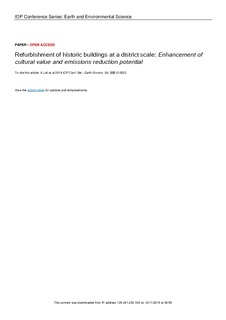| dc.contributor.author | Loli, Arian | |
| dc.contributor.author | Bertolin, Chiara | |
| dc.contributor.author | Kleiven, Tommy | |
| dc.date.accessioned | 2019-11-18T11:12:55Z | |
| dc.date.available | 2019-11-18T11:12:55Z | |
| dc.date.created | 2019-09-18T12:07:39Z | |
| dc.date.issued | 2019 | |
| dc.identifier.citation | IOP Conference Series: Earth and Environmental Science (EES). 2019, 352 . | nb_NO |
| dc.identifier.issn | 1755-1307 | |
| dc.identifier.uri | http://hdl.handle.net/11250/2628983 | |
| dc.description.abstract | The historic buildings have a significant value in providing a sense of identity to the cities and the community. On the other hand, due to their age, they show the highest ratio of living discomfort and energy consumption. Therefore, their refurbishment is a very important process because, if done right, it will not only reduce their energy demand and increase the living comfort and sense of cultural identity, but will also strengthen the social and cultural benefits through leisure and tourism. In the city of Trondheim, as in many other European cities, the historic buildings have been erected in different architectural periods, which manifest diverse historic and technical features. A categorisation of the wall sections of historic buildings has been done for each city’s development period regarding their construction material and technique, building functionality and protection status. The scope of the article is to estimate the potential for reduction of greenhouse gas emissions at a street/neighbourhood/city level prior to applying large-scale intervention measures. This can be achieved by proposing refurbishment alternatives for wall and window sections that preserve the historic value and at the same time, approach or even meet the actual technical standards. Afterwards, the carbon footprint of the refurbishment action itself and the environmental benefits after the refurbishment (operational phase) is estimated for each category of wall sections. The environmental results, multiplied with the total surface of sections carrying the same attributes, give the overall potential of reduction for the entire group of buildings. Based on this, the on-site renewable energy that would lead to achieving zero-emission targets can be calculated. The framework is also important because it does not treat each building separately, but it suggests refurbishment scenarios for specific categories of buildings built in different historical periods. | nb_NO |
| dc.language.iso | eng | nb_NO |
| dc.publisher | IOP Publishing | nb_NO |
| dc.relation.uri | https://iopscience.iop.org/article/10.1088/1755-1315/352/1/012023 | |
| dc.rights | Navngivelse 4.0 Internasjonal | * |
| dc.rights.uri | http://creativecommons.org/licenses/by/4.0/deed.no | * |
| dc.title | Refurbishment of historic buildings at a district scale: Enhancement of cultural value and emission reduction potential | nb_NO |
| dc.type | Journal article | nb_NO |
| dc.type | Peer reviewed | nb_NO |
| dc.description.version | publishedVersion | nb_NO |
| dc.source.pagenumber | 11 | nb_NO |
| dc.source.volume | 352 | nb_NO |
| dc.source.journal | IOP Conference Series: Earth and Environmental Science (EES) | nb_NO |
| dc.identifier.doi | 10.1088/1755-1315/352/1/012023 | |
| dc.identifier.cristin | 1726164 | |
| dc.description.localcode | Content from this work may be used under the terms of theCreative Commons Attribution 3.0 licence. Any further distribution of this work must maintain attribution to the author(s) and the title of the work, journal citation and DOI. Published under licence by IOP Publishing Ltd | nb_NO |
| cristin.unitcode | 194,61,55,0 | |
| cristin.unitname | Institutt for arkitektur og teknologi | |
| cristin.ispublished | true | |
| cristin.fulltext | original | |
| cristin.qualitycode | 1 | |

